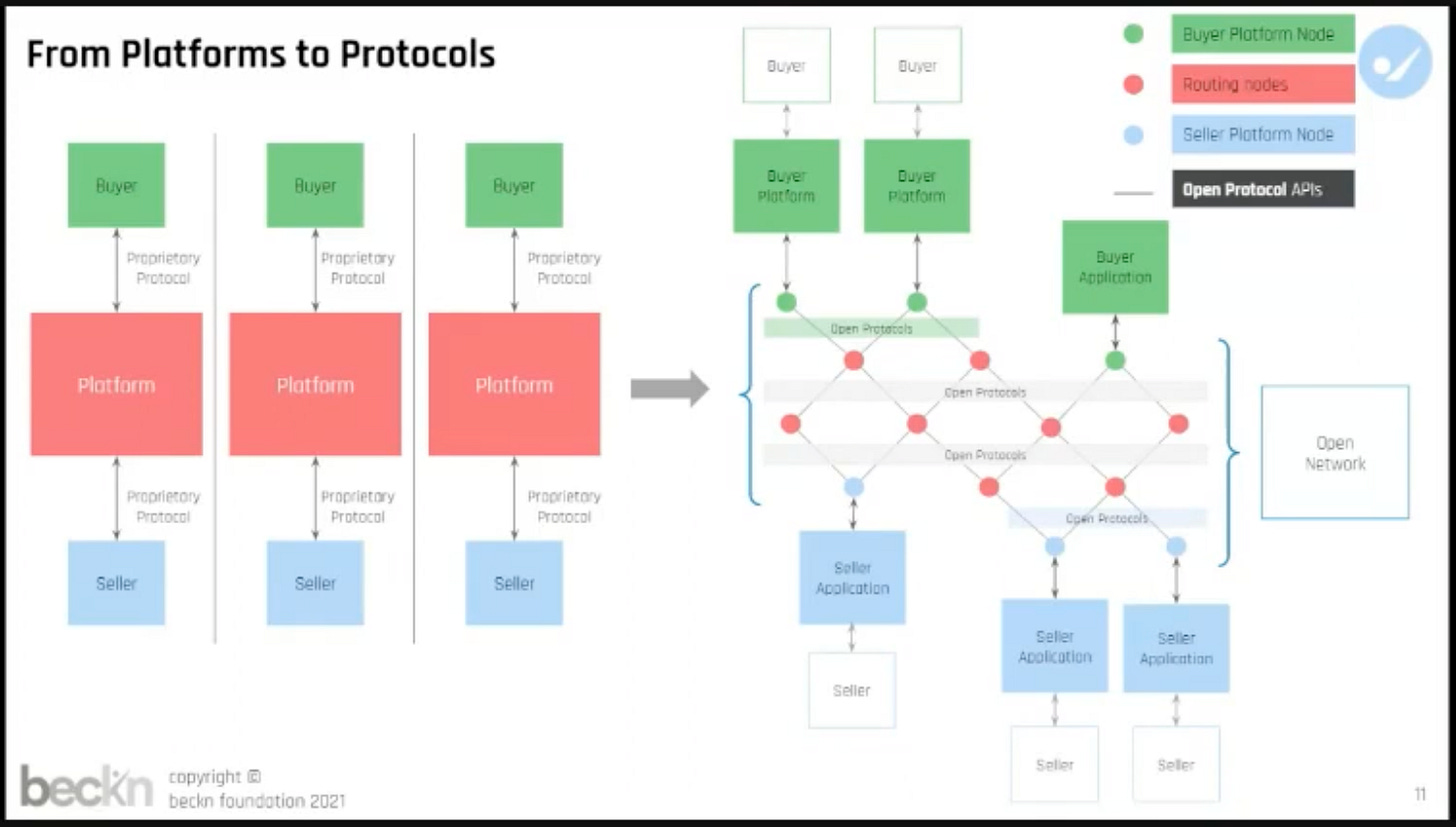ONDC: An Open Network for Ecommerce
Summary: Open networks provide the means for increased freedom and autonomy as more of our lives move to the digital realm. ONDC is an experiment launching in India that is hoping to bring these benefits to shoppers and merchants.
I read about the Open Network for Digital Commerce (ONDC) on Azeem Azhar's Exponential View this week and then saw a discussion of it on the VRM mailing list. I usually take multiple hits on the same thing as a sign I ought to dig in a little more.
Open Network for Digital Commerce is a non-profit established by the Indian government to develop open ecommerce. The goal is to end platform monopolies in ecommerce using an open protocol called Beckn. I'd never heard of Beckn before. From the reaction on the VRM mailing list, not many there had either.
This series of videos by Ravi Prakash, the architect of Beckn, is a pretty good introduction. The first two are largely tutorials on open networks and protocols and their application to commerce. The real discussion of Beckn starts about 5'30" into the second video. One of Beckn's core features is a way for buyers to discover sellers and their catalogs. In my experience with decentralized systems, discovery is one of the things that has to work well.
The README on the specifications indicates that buyers (identified as BAPs) address a search to a Beckn gateway of their choice. If the search doesn't specify a specific seller, then the gateway broadcasts the request to multiple sellers (labeled BPPs) whose catalogs match the context of the request. Beckn's protocol routes these requests to the sellers who they believe can meet the intent of the search. Beckn also includes specifications for ordering, fulfillment, and post-fulfillment activities like ratings, returns, and support.
ONDC's goal is to allow small merchants to compete with large platforms like Amazon, Google, and Flipkart. Merchants would use one of several ONDC-compatible clients to list their catalogs. When a buyer searches, products from their catalog would show up in search results. Small and medium merchants have long held the advantage in being close to the buyer, but lacked ways to easily get their product offerings in front of online shoppers. Platforms hold these merchants hostage because of their reach, but often lack local options. ONDC wants to level that playing field.
Will the big platforms play? The India Times interviewed Manish Tiwary, country Manager for Amazon's India Consumer Business. In the article he says:
I am focused on serving the next 500 million customers. Therefore, I look forward to innovations, which will lift all the boats in the ecosystem.
At this stage, we are engaging very closely with the ONDC group, and we are quite committed to what the government is wanting to do, which is to digitize kiranas, local stores...I spoke about some of our initiatives, which are preceding even ONDC... So yes, excited by what it can do. It's a nascent industry, we will work closely with the government.
From Open Network for Digital Commerce a fascinating idea; excited about prospects: Amazon India exec
Referenced 2022-08-15T10:24:19-0600
An open network for ecommerce would change how we shop online. There are adoption challenges. Not the least of which is getting small merchants to list what they have for sale and keep inventory up to date. Most small merchants don't have sophisticated software systems to interface for automatic updates—they'll do it by hand. If they don't see the sales, they'll not spend the time maintaining their catalog. Bringing the tens of millions of small merchants in India online will be a massive effort.
I'm fascinated by efforts like these. I spend most of my time right now writing about open networks for identity as I wrap up my forthcoming O'Reilly book. I'm not sure anyone really knows how to get them going, so it takes a lot of work with more misses than hits. But I remain optimistic that open networks will ultimately succeed. Don't ask me why. I'm not sure I can explain it.
Photo Credit: Screenshots from Beckn tutorial videos from Ravi Prakash (CC BY-SA 4.0)



